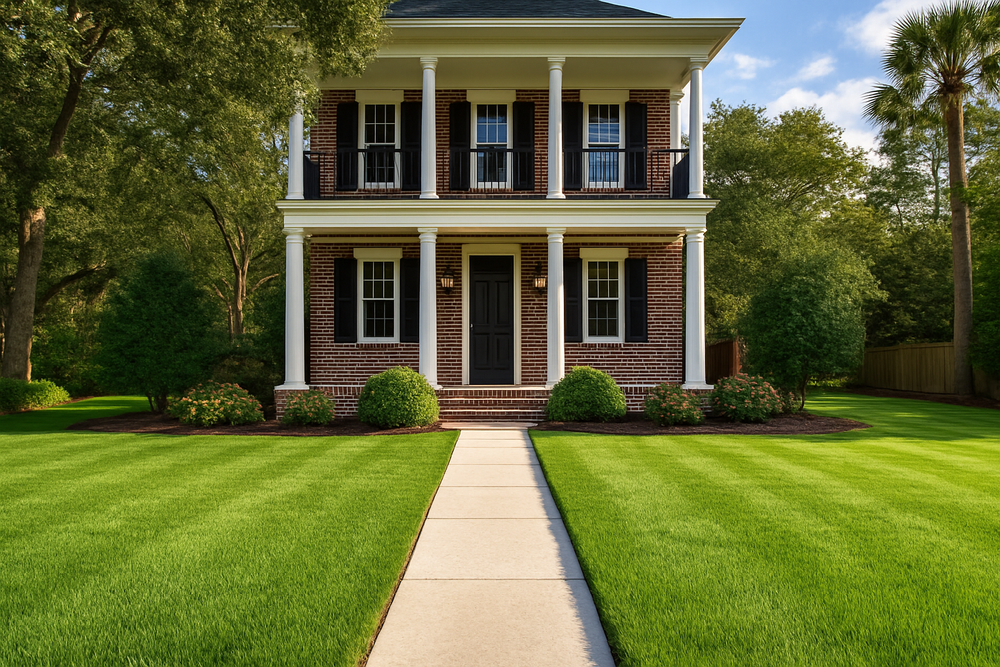Charleston Sod Guide | Best Grass Types & Lawn Care Tips for Charleston, SC
Posted by Farm2Yard on Oct 6th 2025
Charleston Sod Guide: Best Grass Types and Lawn Care Tips for the Lowcountry
Charleston’s Climate: What It Means for Your Lawn
Charleston, South Carolina sits in a humid subtropical climate—hot, humid summers and mild winters. Average highs reach the upper 80s °F from June through September, while winter rarely drops below 40 °F. This means warm-season grasses thrive, going dormant and brown in winter but returning lush in spring.
Charleston’s coastal conditions—salt spray, humidity, sandy soils, and heavy rainfall—require sod that tolerates heat, moisture, and salinity. Homeowners should focus on heat-tolerant, disease-resistant grasses recommended for the Lowcountry by Clemson University Extension.
Best Sod Types for Charleston, SC
Choosing the right sod ensures a healthy, resilient lawn year-round. Here are the top turfgrass options recommended by Clemson HGIC for Charleston’s coastal climate:
1. Bermudagrass
-
Ideal for: Full-sun lawns, high-traffic areas.
-
Benefits: Excellent drought tolerance, quick recovery from wear, and deep green color in summer.
-
Challenges: Poor shade tolerance; requires regular mowing and dethatching.
-
Maintenance Calendar: Clemson Bermudagrass Maintenance Guide.
2. Zoysiagrass
-
Ideal for: Partial-shade yards seeking a soft, dense turf.
-
Benefits: Good heat and shade tolerance, fine-textured blades, and lower water demand than St. Augustine.
-
Challenges: Slow to establish; may develop thatch if over-fertilized.
-
Maintenance Calendar: Clemson Zoysiagrass Guide.
3. St. Augustinegrass
-
Ideal for: Coastal or shaded lawns near saltwater.
-
Benefits: Excellent shade and salt tolerance, lush green color in warm months.
-
Challenges: Low cold tolerance; higher water demand; vulnerable to chinch bugs.
-
Maintenance Calendar: St. Augustinegrass Maintenance Tips.
4. Centipedegrass
-
Ideal for: Low-maintenance lawns with minimal traffic.
-
Benefits: Low fertilizer needs, simple upkeep, and thrives in acidic sandy soils.
-
Challenges: Poor drought and wear tolerance; slower to recover from damage.
While Bermuda and Zoysia are the most popular sod choices for Charleston, St. Augustine performs best near coastal neighborhoods, and Centipede offers a low-input option for low-traffic areas.
How Charleston Weather Affects Sod Performance
Charleston’s hot, humid summers and occasional salt exposure directly impact sod health. Here’s how:
-
Humidity & Disease: High humidity encourages fungal diseases like brown patch and large patch. Choose disease-resistant varieties and follow Clemson’s lawn care guidance.
-
Salt Exposure: Coastal lawns benefit from salt-tolerant options like St. Augustine or Zoysia.
-
Summer Drought: Even in humid areas, long dry stretches occur. Water deeply (1–1.5″ per week) early in the morning.
-
Soil Conditions: Charleston soils are often sandy; amend with organic matter before laying sod.
-
Freeze Events: Rare winter frosts can temporarily damage St. Augustine or Zoysia—don’t panic; they’ll recover when temperatures rise.
Seasonal Lawn Care Schedule for Charleston, SC
Winter (Dec–Feb): Dormant Period
-
Keep turf mowed slightly shorter before dormancy.
-
Apply pre-emergent herbicide in February to prevent summer weeds like crabgrass.
-
Irrigate lightly if the winter is dry.
-
Submit a soil test through Clemson Extension to plan fertilization for spring.
Spring (Mar–May): Green-Up Season
-
Resume mowing at species-specific height (e.g., 1–1.5″ for Bermuda, 2.5–3″ for St. Augustine).
-
Apply the first nitrogen fertilizer when the grass is fully green.
-
Aerate or dethatch once growth is active.
-
Repair thin spots with plugs or fresh sod.
Summer (Jun–Aug): Growth & Stress
-
Mow regularly at recommended height; never remove more than one-third of the blade.
-
Water deeply 2–3 times per week, depending on rainfall.
-
Scout for mole crickets, chinch bugs, and lawn grubs.
-
Avoid over-fertilizing during peak heat—it increases thatch and disease risk.
Fall (Sep–Nov): Prepare for Dormancy
-
Apply the final fertilizer in early fall; avoid late nitrogen applications.
-
Spot-treat weeds and reduce irrigation as temperatures cool.
-
Continue mowing until growth stops, then lower the mowing height slightly before winter.
Best Time to Lay Sod in Charleston
The best time to install new sod in Charleston is late spring through early summer—typically April through June. Warm soil encourages strong root development before the hottest months.
If needed, early fall installations (September–October) are possible, provided temperatures remain above 60°F. Avoid winter installation; cold soils slow rooting and increase disease risk.
Follow Clemson’s step-by-step lawn establishment guide for best results.
Expert Tips for Healthy Charleston Lawns
-
Test your soil before laying sod to adjust pH and nutrients.
-
Prep the site properly—remove debris, till the top 4–6 inches, and grade for drainage.
-
Install fresh sod quickly after delivery to prevent drying or heat stress.
-
Water immediately after installation, keeping sod moist for the first two weeks.
-
Mow only after rooting, usually two to three weeks post-installation.
-
Aerate annually to prevent compaction and promote deeper roots.
-
Use integrated pest management to control insects and weeds without harming beneficial organisms.
-
Raise mower height in summer to reduce stress during high heat.
-
Use edging barriers to prevent invasive spread of Bermuda into flowerbeds.
-
Consult Clemson Extension or local sod suppliers for cultivar recommendations suited to your microclimate.
Charleston Sod Summary
|
Lawn Condition |
Recommended Sod Type |
Key Advantages |
|
Full sun, high traffic |
Drought tolerant, durable |
|
|
Partial shade |
Balanced performance, attractive look |
|
|
Coastal / salt exposure |
Best salt tolerance |
|
|
Low maintenance |
Minimal fertilizer needs |
Ready to Install New Sod in Charleston?
For Charleston homeowners, choosing the right sod means a greener, longer-lasting lawn that fits the Lowcountry lifestyle. Whether you prefer Bermuda’s resilience, Zoysia’s lush carpet, or St. Augustine’s shade tolerance, the key is matching your grass to the local environment and maintaining it seasonally.

